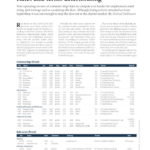Non-operating owners of container ships have to compete ever harder for employment amid rising spot tonnage and an escalating idle fleet. Although fixing activity returned as from September, it was not enough to stop the slow rot in the charter market. By Michael Hollmann
Rate levels for the 1,100-4,250 TEU spectrum were down almost 4.0% month-on-month as per 18 October, according to[ds_preview] the New ConTex. The Howe Robinson Containership Index, which also tracks the traditional post-panamax and the smallest feeder classes, slipped by 7.0% month-on-month. Downward pressure has been most severe for large gearless vessels in the 5,500-7,500 TEU segment, for panamaxes and for feeder/handy types between 1,000 and 2,000 TEU.
Overall, the short-term outlook for the container trades continued to worsen over the past weeks. All the fresh data coming in only confirms that trade growth is more and more limited to the transpacific and shorthaul Intra-Asia trades. According to Container Trades Statistics (CTS), volume growth on the routes from Asia to North Europe and the Mediterranean combined is down to a marginal 0.1% for the first eight months. It is even down –1.1% only for the trade to North Europe.
Due to the effects of the Turkish currency crisis on imports to Turkey, volume growth to the Mediterranean is expected to weaken as well. The situation is even worse in the Far East/Middle East trade with year-on-year reductions of close to 8% each month between June and August. However, despite the US/China trade war, transpacific eastbound traffic increased by more than 5.0% so far this year.
Given the patchy demand side it is no surprise that the overall share of idle container ships 2.3% of the world fleet again as start of October. Analysts predict a further substantial increase as a couple of service closures were delayed by typhoons and hurricanes worldwide.
Trends in tonnage availability in the charter market have been alarming as well, especially for the 5,500-7,500 TEU, 4,000-5,100 and the 1,000-2,000 TEU sectors. One London broker counted 126 vessels available on a spot/prompt basis as per start of October versus an average of just 60 during the previous three months and only 13 back in April. Most of the open vessels in the larger sectors are concentrated in Asia but smaller tonage sits in the Atlantic.
Some sectors that were showing more resilience over the past weeks were super-post-panamax tonnage in excess of 7,500 TEU, 3,400 TEU class and 2,700 TEU class ships. Following a steep fall of charter rates, several carriers were enticed back into the market to fix or extend the largest gearless vessels, including some multi-year deals for 10,000 TEU ships by Hapag-Lloyd, as brokers reported.
The effect was that rates stabilised and even recovered slightly as illustrated by the extension of the circa 8,200 »Conti Annapurna« at 13,250 $/day by the Shipping Corporation of India. Latest information from brokers was that spot supply of ships in excess of 7,500 TEU was stable at just three vessels.
By contrast, the next smaller segment of 5,500-7,500 TEU has seen no signs of support so far, with spot supply climbing to more than a dozen units and rate levels for older 5,500-6,000 TEU class tonnage falling to mid 8,000’s $/day in one benchmark fixture in Asia. Worse yet for owners, charterers have started implementing extremely flexible period durations again, with a couple of vessels fixing 2-12 months. Owners are thus left with no planning certainty and no doubt, the ships are going to be redelivered as early as possible if rates continue to fall.
The panamax segment remained relatively busy, keeping the volume of spot tonnage fairly low up until early October. Since then, more and more ships were piling up in spot positions as fresh activity could not absorb the volume of redeliveries. The pool of spot vessels worldwide grew to 18 units by the middle of October, almost all of them located in Asia. Rate levels have been slipping faster since then, falling below 11,000 $/day and stabilising in a range from 10,000 to 10,500 $/day after a mini-spike in fixing activity in Asia in week 42.
The 2,500-2,800 TEU sub-panamax classes are still maintain rate levels in the low 5-digits after only modest falls during the past weeks. Popular Aker 2,700 TEU designs still achieved more than 11,000 $/day while Mipo designs got fixed in the mid/high 10,000’s $/day in Asia. In the feeder/handy segments below 2,000 TEU, owners are generally faced with limited employment opportunities in all regions.
The workhorse 1,700 TEU type has now seen fixing levels drift below 9,000 $/day in Asia and even in the Caribbean, as excess spot supply is spread both across the Atlantic and the Pacific. Even modern fuel-efficient ships are reportedly struggling to secure employment, with rates in Asia established below 12,000 $/day now.
The market in the smaller feeder segments of 1,100 TEU and smaller is sluggish basically in all regions and owners are competing heavily even for very short interim employments, brokers report. Activity in the 700 TEU segment remained very limited, however with the few fixtures that were reported still concluded at around last done levels of flat or low 5,000’s $/day.
Michael Hollmann


















